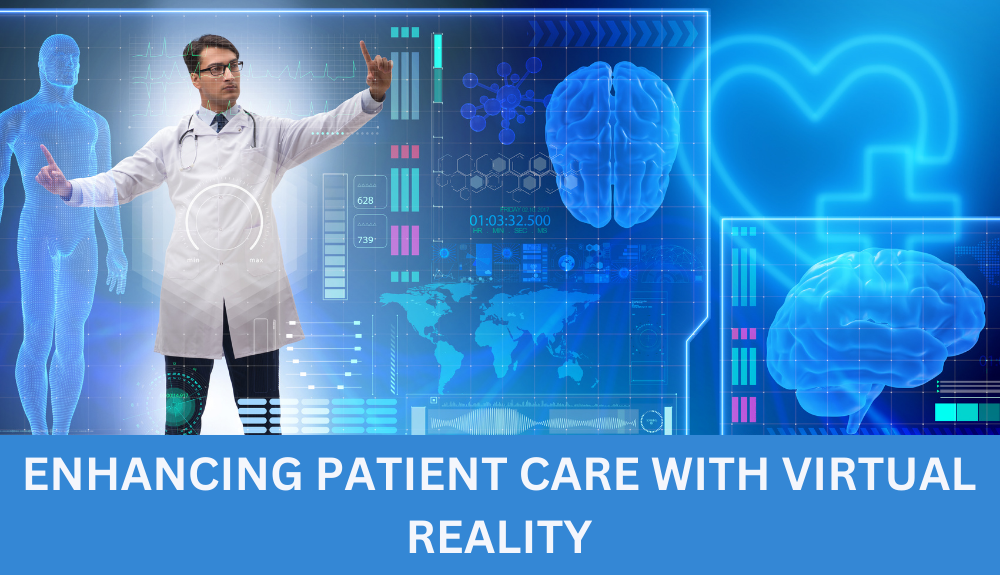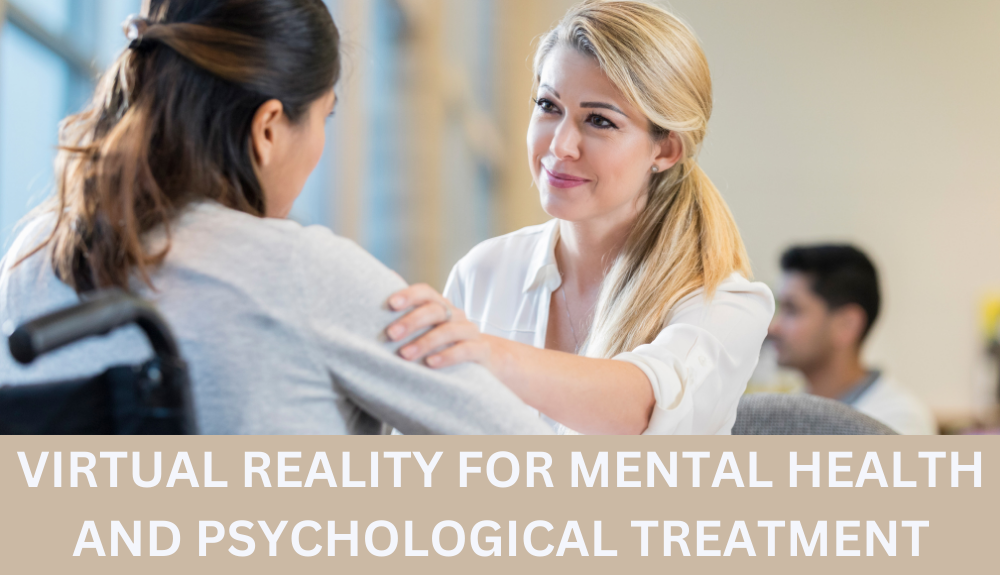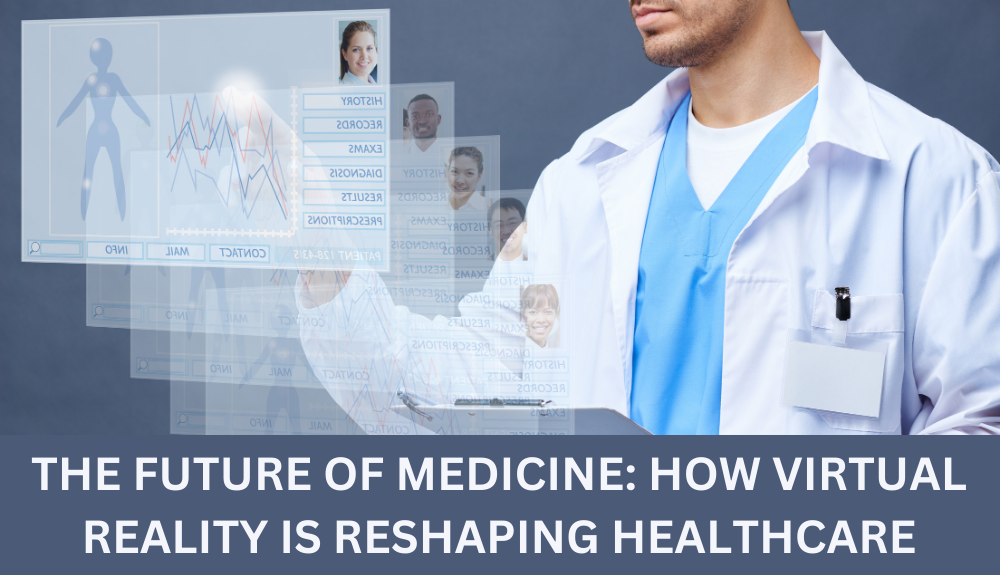Are you ready to step into the future of medicine? Imagine a world where virtual reality can revolutionize healthcare, transforming the way we diagnose, treat, and even prevent illnesses.
Picture this: a patient puts on a VR headset and suddenly finds themselves immersed in a virtual environment where they can explore the inner workings of their own body, visualize complex medical procedures, or manage chronic pain through immersive experiences. It’s not science fiction, but a rapidly emerging reality that is reshaping the healthcare landscape as we know it.
In this blog, we will delve into the exciting advancements in virtual reality technology and how it is being applied in various areas of healthcare. We will explore the potential benefits and challenges that come with integrating VR into medical practice. From the use of VR in mental health therapy to enhancing surgical training, we will cover it all.
Get ready to embark on a journey that will unveil the countless possibilities of virtual reality in healthcare. Whether you’re a healthcare professional, a patient, or simply curious about the future of medicine, this blog will provide you with valuable insights and inspire you to reimagine the possibilities. So let’s dive in and discover how virtual reality is shaping the future of healthcare.
Short Summary
- Virtual reality (VR) is revolutionizing the healthcare industry by transforming how we diagnose, treat, and prevent illnesses.
- VR is being used in medical training and education to provide immersive experiences for students and professionals, enhancing their skills and knowledge.
- The integration of VR in patient care offers new possibilities, allowing healthcare providers to improve treatment outcomes and deliver personalized care.
- VR is also proving to be effective in pain management, providing patients with immersive experiences that help reduce pain levels.
- Physical therapy is being enhanced through the use of VR, allowing patients to engage in interactive exercises that improve motor function and rehabilitation.
- Virtual reality has the potential to significantly impact mental health and psychological treatment, offering therapeutic experiences for conditions such as post-traumatic stress disorder and migraine headaches.
- The future of medicine lies in virtual reality, and its applications in healthcare are vast and exciting.
- In conclusion, virtual reality is reshaping healthcare by offering innovative solutions and improving patient outcomes.
1. The Impact of Virtual Reality on the Healthcare Industry
In recent years, virtual reality (VR) technology has made significant advancements and has begun to revolutionize the healthcare industry. This immersive technology has the potential to reshape medical care, improve patient outcomes, and revolutionize medical education and training. Let’s explore the various ways virtual reality is impacting the healthcare industry.
1.1 Enhanced Medical Training and Education
Virtual reality provides medical students, residents, and healthcare professionals with a unique opportunity to learn and train in a simulated environment that closely resembles real-world scenarios. By using VR headsets, medical professionals can practice complex surgical procedures, learn to diagnose and treat various medical conditions, and improve their decision-making skills. This allows medical students and professionals to gain practical experience in a safe and controlled environment before applying their skills in the real world.
“Virtual reality in medical training offers an immersive and realistic learning experience, allowing medical professionals to refine their skills and enhance patient care.” Dr. Sarah Thompson, Virtual Reality Researcher
1.2 Pain Management and Rehabilitation
Virtual reality has emerged as an effective tool for pain management and rehabilitation. By immersing patients in virtual environments, VR technology can help distract them from pain and discomfort during medical procedures, physical therapy sessions, or chronic pain management. Additionally, virtual reality simulations can assist individuals in rehabilitating motor function, improving spatial awareness, and regaining strength and coordination after an injury or stroke.
“Virtual reality can provide a safer environment for rehabilitation therapy, allowing patients to immerse themselves in a virtual world that enhances their recovery process.” Dr. Michael Chen, Rehabilitation Specialist
1.3 Mental Health Treatment
Virtual reality has shown promising results in the field of mental health treatment. It can be utilized to expose patients to anxiety-provoking situations in a controlled environment, helping them gradually overcome their fears and anxiety. VR simulations can also be used as a tool for exposure therapy in treating post-traumatic stress disorder (PTSD) or phobias. Moreover, virtual reality environments can promote relaxation, mindfulness, and stress reduction for individuals suffering from mental health disorders.
“Virtual reality has the potential to transform mental health treatment by creating a safe space for patients to confront and manage their fears and anxieties.” Dr. Lisa Walker, Mental Health Specialist
1.4 Improved Patient Care and Communication
With virtual reality, healthcare providers can enhance communication with patients by using immersive technologies to explain medical conditions, treatment plans, and surgical procedures in a visual way.
2. Virtual Reality in Medical Training and Education
Virtual Reality (VR) technology is revolutionizing the field of medical training and education. With its ability to create immersive and realistic virtual environments, VR is reshaping how healthcare professionals are trained and educated. This section explores the various applications of VR in medical training and education, highlighting its positive impact on the healthcare industry.
1. Enhanced Medical Education:
Virtual reality allows medical students to move beyond textbooks and traditional lectures by providing them with a hands-on learning experience. Through VR simulations, students can immerse themselves in realistic scenarios and practice complex procedures in a safe and controlled environment. This not only enhances their understanding of medical concepts but also improves their critical thinking and decision-making skills.
Quote: “Virtual reality offers a transformative learning experience for medical students, providing them with realistic scenarios and allowing them to practice procedures in a controlled environment.”
2. Surgical Training and Preparation:
One of the most promising applications of VR in healthcare is surgical training and preparation. Surgeons can use VR simulations to practice intricate surgical procedures before performing them on actual patients. This allows them to refine their techniques, reduce errors, and improve patient safety. Furthermore, VR can also be used to train and familiarize medical professionals with new surgical equipment and technologies.
3. Virtual Patient Simulations:
VR technology enables the creation of virtual patients who exhibit various medical conditions and symptoms. Healthcare professionals can interact with these virtual patients and diagnose, treat, and manage their conditions. This hands-on experience provides valuable practical training, allowing medical practitioners to develop their clinical skills in a risk-free environment.
4. Pain Management and Rehabilitation:
VR has proven to be effective in pain management and rehabilitation therapies. By immersing patients in virtual environments, VR can effectively distract them from pain sensations and alleviate discomfort. Additionally, VR can be used in physical therapy to simulate real-world scenarios and help patients regain motor function. This immersive approach enhances therapy outcomes and accelerates the rehabilitation process.
Applications of VR in Medical Training and Education
Enhanced Medical Education
Surgical Training and Preparation
Virtual Patient Simulations
Pain Management and Rehabilitation
💡 key Takeaway: Virtual Reality is transforming medical training and education by providing a realistic and immersive learning experience. It enhances medical education, facilitates surgical training, offers virtual patient simulations, and improves pain management and rehabilitation therapies.
3. Enhancing Patient Care with Virtual Reality

Virtual Reality (VR) technology has emerged as a groundbreaking tool in the healthcare industry, revolutionizing the way medical professionals provide care and enhancing patient outcomes. By immersing patients in realistic virtual environments, VR offers a wide range of applications that go beyond traditional treatment methods. Let’s explore how virtual reality is reshaping patient care and transforming the healthcare landscape.
1. Pain Management and Rehabilitation:
Virtual reality simulations have proven to be highly effective in managing pain and facilitating rehabilitation. By creating immersive virtual worlds, patients can be transported away from their physical discomfort, effectively reducing their perception of pain. This technology is especially valuable for chronic pain sufferers and individuals undergoing physical therapy, as it provides a safe and controlled environment for rehabilitation exercises. VR simulations also offer engaging and interactive experiences that motivate patients to actively participate in their recovery process.
“For patients dealing with chronic pain or undergoing rehabilitation, virtual reality technology provides a novel approach to managing discomfort and promoting physical progress.”
2. Mental Health Treatment:
Virtual reality has also shown great potential in the field of mental health. Patients dealing with conditions such as post-traumatic stress disorder (PTSD), anxiety disorders, and phobias can benefit from exposure therapy conducted in virtual environments. By gradually exposing patients to anxiety-inducing situations, VR technology allows therapists to guide them through a safe and controlled environment, helping them overcome their fears and manage their symptoms. The immersive nature of VR enhances the effectiveness of therapy, as patients can experience situations that are difficult or impossible to replicate in the real world.
“Virtual reality-based exposure therapy offers a powerful tool for mental health professionals to treat patients suffering from trauma-related disorders and anxiety.”
3. Medical Training and Education:
Virtual reality has revolutionized medical education by providing immersive and realistic training experiences for medical students and healthcare professionals. Medical students can now practice complex surgical procedures in virtual environments, allowing them to gain valuable hands-on experience without risking patient safety. VR simulations also enable healthcare providers to improve their diagnostic skills and decision-making abilities. By replicating real-world scenarios, medical professionals can prepare themselves for challenging situations and refine their techniques in a safe and controlled setting.
“Virtual reality-based medical training offers a game-changing approach that enhances the skills and expertise of future healthcare professionals.”
💡 key Takeaway: Virtual reality technology is transforming patient care by offering innovative solutions in pain management, mental health treatment, and medical training. By immersing patients in realistic virtual environments, VR enhances their experience, accelerates their recovery.
4. Virtual Reality Applications in Pain Management
Virtual Reality (VR) technology is revolutionizing various aspects of the healthcare industry, including pain management. With the use of immersive virtual environments, VR has shown promising results in mitigating pain and improving patients’ overall well-being.
1. Reducing Physical Pain: Virtual reality simulations create a virtual world that transports patients away from their physical surroundings. These virtual environments provide a distraction from pain, diverting the patient’s focus, and reducing their perception of pain. By engaging the patient’s visual and auditory senses, VR technology helps in managing acute and chronic pain levels effectively (keyword: pain level).
2. Enhancing Physical Therapy: VR has also proven to be beneficial in the realm of physical therapy. Patients undergoing rehabilitation therapy can use virtual reality simulations to perform exercises while being immersed in a virtual environment. This allows for a more engaging and enjoyable experience, ultimately encouraging patients to actively participate in their therapy sessions. By combining movement with the immersive nature of VR, patients can improve their mobility, motor function, and overall rehabilitation progress (keywords: physical therapy, motor function, rehab therapy).
3. Addressing Mental Health: Virtual reality has shown promise in treating mental health conditions such as post-traumatic stress disorder (PTSD) and anxiety disorders. Through VR simulations, patients can safely confront and navigate triggering situations in a controlled and supervised virtual environment. This exposure therapy technique helps desensitize patients and reduce their anxiety levels, allowing them to regain control over their lives (keywords: mental health, post-traumatic stress disorder).
4. Providing Medical Training: Medical professionals, including students and experienced healthcare providers, can benefit from virtual reality in terms of medical training and education. VR simulations offer realistic scenarios that allow medical students to practice complex surgical procedures without risking patient safety. This immersive technology enables medical professionals to refine their skills, enhance decision-making abilities, and gain confidence in their expertise (keywords: medical training, medical education, healthcare professional, healthcare provider).
💡 key Takeaway: Virtual reality applications hold immense potential in pain management, physical therapy, mental health treatment, and medical training. By creating a virtual world, VR technology offers patients and healthcare professionals a safer, more engaging, and effective alternative to traditional methods.
5. Improving Physical Therapy with Virtual Reality
Virtual reality (VR) technology is revolutionizing the field of physical therapy, providing innovative solutions to enhance patient outcomes and improve rehabilitation processes. By creating an immersive virtual environment, VR headsets can transport patients to interactive and simulated scenarios that facilitate their recovery.
1. Enhanced Engagement and Motivation:
One of the key benefits of integrating VR into physical therapy is its ability to enhance patient engagement and motivation. Traditional therapy exercises can often be repetitive and monotonous, leading to decreased interest and compliance. However, by using VR simulations, patients are immersed in visually appealing and interactive environments, which make therapy sessions more enjoyable and engaging. This increased engagement can lead to greater motivation and improved adherence to therapy protocols, ultimately accelerating the rehabilitation process.
2. Targeted Pain Management:
Managing pain is a crucial aspect of physical therapy, especially for patients recovering from surgeries or dealing with chronic pain conditions. VR technology offers a unique approach to pain management by providing immersive distraction techniques. By immersing patients in virtual scenarios that capture their attention and focus, VR can effectively divert their attention away from the physical discomfort they might be experiencing during therapy sessions. This immersive distraction has shown to reduce the perception of pain, allowing patients to tolerate therapeutic interventions and exercise routines more effectively.
3. Real-World Simulation and Functional Training:
Physical therapy focuses on restoring patients’ functional abilities for everyday activities. With VR, therapists can create realistic simulations that mimic real-world scenarios and challenges patients may encounter, such as climbing stairs, reaching for objects, or walking on uneven surfaces. By immersing patients in these virtual environments, therapists can provide targeted functional training and measure progress in a controlled and safe manner. This immersive approach allows patients to practice and build confidence in performing specific tasks, leading to better outcomes when transitioning back to the real world.
4. Personalized Rehabilitation Programs:
Each patient has unique needs and goals when it comes to their rehabilitation journey. VR technology enables therapists to tailor therapy sessions based on individual capabilities and progress. By adjusting the difficulty level, speed, and intensity of virtual exercises, therapists can create personalized programs that challenge patients at their own pace. This individualized approach not only improves patient engagement but also optimizes therapeutic outcomes by promoting gradual progress and preventing overexertion.
5. Objective Data Collection and Progress Tracking:
One significant advantage of integrating VR into physical therapy is the ability to collect objective data and track patient progress accurately.
6. Virtual Reality for Mental Health and Psychological Treatment

Virtual Reality (VR) has proven to be a game-changer in the healthcare industry, and its applications extend beyond just physical health. One area where VR is making a significant impact is in the field of mental health and psychological treatment.
Virtual reality technology is being used to create immersive environments that help patients with various mental health conditions, such as post-traumatic stress disorder (PTSD), anxiety disorders, and phobias. By providing a virtual environment that mimics real-world situations in a controlled and safe setting, clinicians can expose patients to triggers or stimuli that evoke their symptoms. This exposure therapy can help patients gradually confront their fears and anxieties, leading to desensitization and symptom reduction.
One particular area where VR is proving to be highly effective is in pain management. Studies have shown that immersive VR experiences distract patients from their pain, thereby reducing their perceived pain levels. For patients undergoing painful medical procedures or chronic pain management, immersing them in a virtual world can provide a welcome respite and alleviate their discomfort.
Moreover, virtual reality also has promising applications in psychiatric care. It allows therapists to create scenarios that simulate real-life situations and enable patients to practice coping strategies and learn crucial life skills in a safe and controlled environment. For example, individuals with social anxiety can engage in simulated social interactions to build their confidence and overcome their fears.
Furthermore, virtual reality is transforming medical education and training. Medical students and healthcare professionals can now utilize VR simulations to practice surgical procedures, interact with virtual patients, and hone their diagnostic capabilities. This immersive approach to medical training not only provides a safer environment for learning but also allows healthcare providers to gain hands-on experience and develop their skills before working with real patients.
In conclusion, virtual reality has the potential to revolutionize mental health and psychological treatment. By leveraging the immersive and interactive nature of VR, healthcare professionals can deliver more personalized and effective therapies to patients. From pain management to psychiatric care to medical training, virtual reality is reshaping the way we approach mental health and well-being.
💡 key Takeaway: Virtual reality is being increasingly adopted in mental health and psychological treatment, offering innovative and effective approaches in pain management, exposure therapy, psychiatric care, and medical training. Its immersive and interactive nature allows for personalized experiences, enhancing patient outcomes and revolutionizing the healthcare industry.
Conclusion
In conclusion, virtual reality is poised to revolutionize the healthcare industry, making medical treatments more accessible, engaging, and effective than ever before. With the ability to create realistic simulations, VR technology allows healthcare professionals to train, diagnose, and treat patients in innovative ways. From alleviating pain and anxiety during procedures to enhancing surgical precision, VR has the potential to transform the patient experience and improve outcomes. One of the key benefits of VR in healthcare is its ability to provide immersive therapy for patients with mental health conditions. Virtual reality environments can simulate scenarios that help individuals confront and overcome their fears and phobias, making therapy more engaging and effective.



